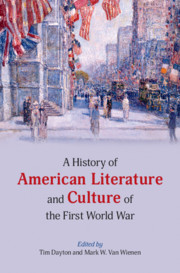Book contents
- A History of American Literature and Culture of the First World War
- A History of American Literature and Culture of the First World War
- Copyright page
- Contents
- Figures
- Contributors
- Acknowledgments
- Introduction America’s Great War at One Hundred (and Counting)
- Part I Genre and Medium
- Part II Settings and Subjects
- Chapter 9 The Peace Movement
- Chapter 10 Americans in France
- Chapter 11 German Americans
- Chapter 12 The English in America
- Chapter 13 Preparedness
- Chapter 14 Propaganda
- Chapter 15 Conscientious Objectors
- Chapter 16 Volunteers
- Chapter 17 African Americans
- Chapter 18 In the Midwest
- Chapter 19 In the South
- Chapter 20 Revolution
- Chapter 21 Monuments and Memorials
- Part III Transformations
- References
- Index
Chapter 21 - Monuments and Memorials
Memory Dissipated
from Part II - Settings and Subjects
Published online by Cambridge University Press: 23 January 2021
- A History of American Literature and Culture of the First World War
- A History of American Literature and Culture of the First World War
- Copyright page
- Contents
- Figures
- Contributors
- Acknowledgments
- Introduction America’s Great War at One Hundred (and Counting)
- Part I Genre and Medium
- Part II Settings and Subjects
- Chapter 9 The Peace Movement
- Chapter 10 Americans in France
- Chapter 11 German Americans
- Chapter 12 The English in America
- Chapter 13 Preparedness
- Chapter 14 Propaganda
- Chapter 15 Conscientious Objectors
- Chapter 16 Volunteers
- Chapter 17 African Americans
- Chapter 18 In the Midwest
- Chapter 19 In the South
- Chapter 20 Revolution
- Chapter 21 Monuments and Memorials
- Part III Transformations
- References
- Index
Summary
World War I triggered a memorial boom unparalleled in US history as constituencies of every stripe rushed to commemorate the role of “their boys” in the conflict. The memorials, numbering in the thousands, assumed both traditional forms and myriad new guises, including the Tomb of the Unknown Soldier and a host of unprecedented “useful memorials”—such as bridges, community centers, and football stadiums—whose commemorative suitability was hotly debated. “Great men” sculptures were eschewed while honor rolls of the dead became ubiquitous. Well-known artists created powerful sculptural memorials, including some that evinced disillusionment with the war, but most memorial sculpture—to the chagrin of the art world—comprised commercially produced doughboys, often in heroic poses. Despite their omnipresence, the memorials largely failed to fix the war’s place in American memory: No commemorative form could sufficiently compensate for the war’s ambiguous narrative and unsettled meaning, especially in the wake of US participation in the Second World War. The centennial period has brought renewed attention to World War I memorials and has catalyzed an effort to erect a national World War I memorial in Washington, DC.
Keywords
- Type
- Chapter
- Information
- Publisher: Cambridge University PressPrint publication year: 2021
- 1
- Cited by



